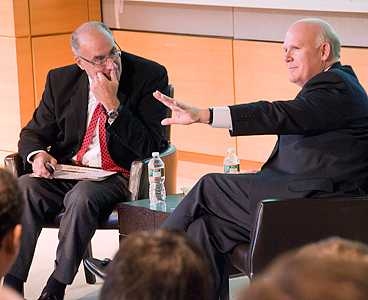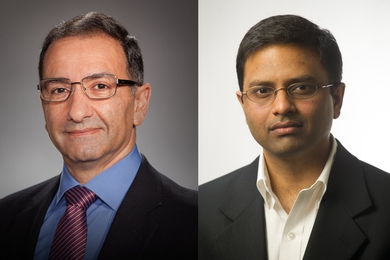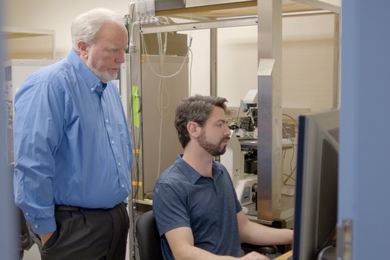The General Motors Company needs an abrupt cultural shift to correct decades of reactive leadership, the company’s chairman and CEO Dan Akerson said at the MIT Sloan School of Management on Thursday. The alternative, he suggested, would be another round of spectacular failure at one of the country’s cornerstone companies.
“I’ve told the Treasury this,” Akerson said. “We don’t deserve a second chance. We do it right now or it’s over.”
Akerson, who took over as GM's CEO in September 2010 and as chairman last month, was on campus for a talk as part of the MIT Sloan Dean’s Innovative Leader Series.
Since joining GM, Akerson has pursued a change in the company’s leadership culture, all while using the unique opportunity of a $50 billion government bailout to position the carmaker as an innovative market leader looking toward future generations.
In the 1960s, GM's U.S. market share had reached its peak — nearly 50 percent. By 2000, the company was still the worldwide leader in sales, but U.S. market share had dropped to 28 percent. In 2007, GM lost its worldwide leader title to Toyota amid company struggles. In early 2010, however, GM logged its first quarterly profit in nearly three years.
“We have to play like we’re the upstart,” Akerson said. “Culturally, we have to ingrain that in our management and our thinking."
Akerson, whose career in telecommunications includes leading both MCI and Nextel, has met skepticism as an outsider in Detroit, where the sheer size and unique qualities of the automotive industry are a point of pride.
But in conversation with Howard Anderson, the Bill Porter (1967) Distinguished Senior Lecturer of Entrepreneurship, he declined the opportunity to place blame for the collapse on GM's engineers, developers or workforce.
“It’s leadership who did not execute well at GM,” Akerson said. “They did not anticipate, look over the horizon, and make a move.
“There was this almost passive willingness to buy into a fantasy that the world was not going to change,” he said about the company’s failure to assume or predict a shifting industry.
Akerson said GM needs research and development “breakthroughs” to develop cars running on alternative energy. GM in December debuted the Chevy Volt, an extended-range electric vehicle touted to run up to 40 miles on a lithium-ion battery and up to 40 miles per gallon when supported by a gas engine. Akerson called the Volt “a start.”
He said cars running on natural gas or hydrogen fuel cells are particularly worth pursuing. GM has a hydrogen-fuel-cell vehicle currently in development, Akerson said.
Worldwide expansion, especially in China, is also critical to GM’s long-term sustainability, Akerson said. The company has undertaken a region-based approach to sales in China with targeted marketing to match.
Akerson spoke at length about GM’s collaboration with the government-owned Shanghai Automotive Industry Corporation and batted away concerns of compromising GM’s intellectual property, instead comparing the relationship to a long and stable — if not consistently harmonious — marriage.
Akerson joined the GM board in July 2009 at the behest of the Obama administration, just as GM emerged from bankruptcy, bolstered by the government’s $50 billion bailout. The automotive industry landscape just prior to that was bleak, with labor conflict, overproduction and overseas competition forcing The Big Three — GM, Ford and Chrysler — into what Akerson called a “death spiral.” These days, he said, the same companies are often just “The Detroit Three.”
“Humility is a blessing,” he said. “And this industry needed a little bit of it.”
“I’ve told the Treasury this,” Akerson said. “We don’t deserve a second chance. We do it right now or it’s over.”
Akerson, who took over as GM's CEO in September 2010 and as chairman last month, was on campus for a talk as part of the MIT Sloan Dean’s Innovative Leader Series.
Since joining GM, Akerson has pursued a change in the company’s leadership culture, all while using the unique opportunity of a $50 billion government bailout to position the carmaker as an innovative market leader looking toward future generations.
In the 1960s, GM's U.S. market share had reached its peak — nearly 50 percent. By 2000, the company was still the worldwide leader in sales, but U.S. market share had dropped to 28 percent. In 2007, GM lost its worldwide leader title to Toyota amid company struggles. In early 2010, however, GM logged its first quarterly profit in nearly three years.
“We have to play like we’re the upstart,” Akerson said. “Culturally, we have to ingrain that in our management and our thinking."
Akerson, whose career in telecommunications includes leading both MCI and Nextel, has met skepticism as an outsider in Detroit, where the sheer size and unique qualities of the automotive industry are a point of pride.
But in conversation with Howard Anderson, the Bill Porter (1967) Distinguished Senior Lecturer of Entrepreneurship, he declined the opportunity to place blame for the collapse on GM's engineers, developers or workforce.
“It’s leadership who did not execute well at GM,” Akerson said. “They did not anticipate, look over the horizon, and make a move.
“There was this almost passive willingness to buy into a fantasy that the world was not going to change,” he said about the company’s failure to assume or predict a shifting industry.
Akerson said GM needs research and development “breakthroughs” to develop cars running on alternative energy. GM in December debuted the Chevy Volt, an extended-range electric vehicle touted to run up to 40 miles on a lithium-ion battery and up to 40 miles per gallon when supported by a gas engine. Akerson called the Volt “a start.”
He said cars running on natural gas or hydrogen fuel cells are particularly worth pursuing. GM has a hydrogen-fuel-cell vehicle currently in development, Akerson said.
Worldwide expansion, especially in China, is also critical to GM’s long-term sustainability, Akerson said. The company has undertaken a region-based approach to sales in China with targeted marketing to match.
Akerson spoke at length about GM’s collaboration with the government-owned Shanghai Automotive Industry Corporation and batted away concerns of compromising GM’s intellectual property, instead comparing the relationship to a long and stable — if not consistently harmonious — marriage.
Akerson joined the GM board in July 2009 at the behest of the Obama administration, just as GM emerged from bankruptcy, bolstered by the government’s $50 billion bailout. The automotive industry landscape just prior to that was bleak, with labor conflict, overproduction and overseas competition forcing The Big Three — GM, Ford and Chrysler — into what Akerson called a “death spiral.” These days, he said, the same companies are often just “The Detroit Three.”
“Humility is a blessing,” he said. “And this industry needed a little bit of it.”






